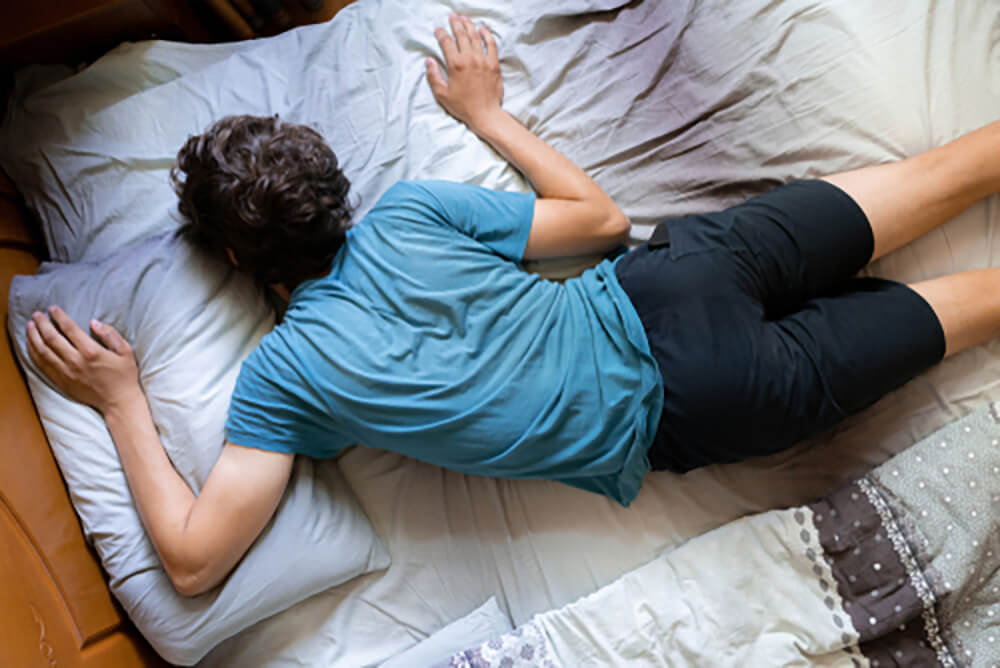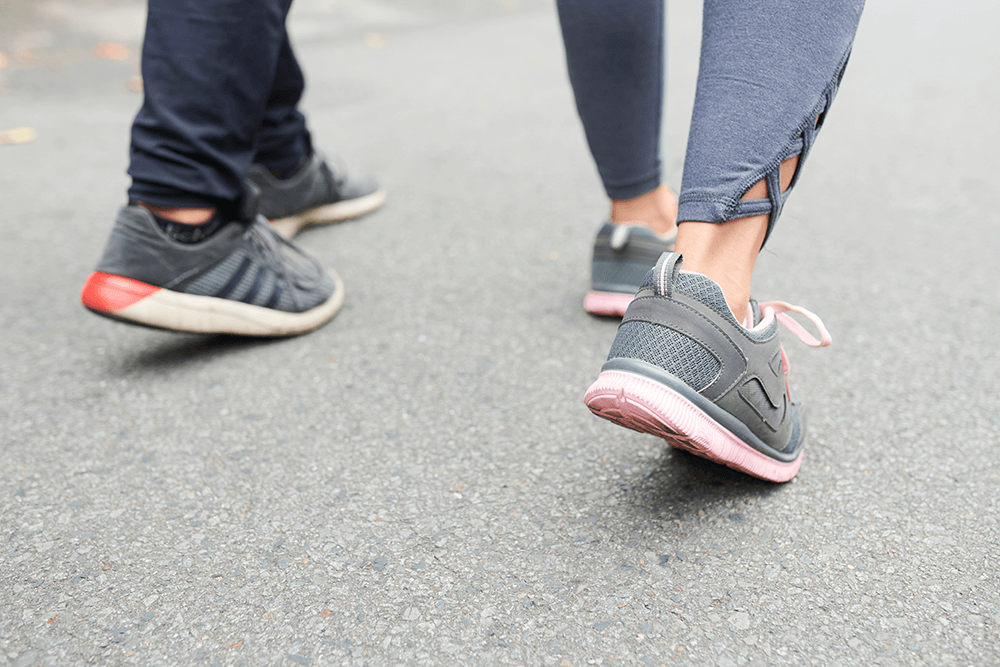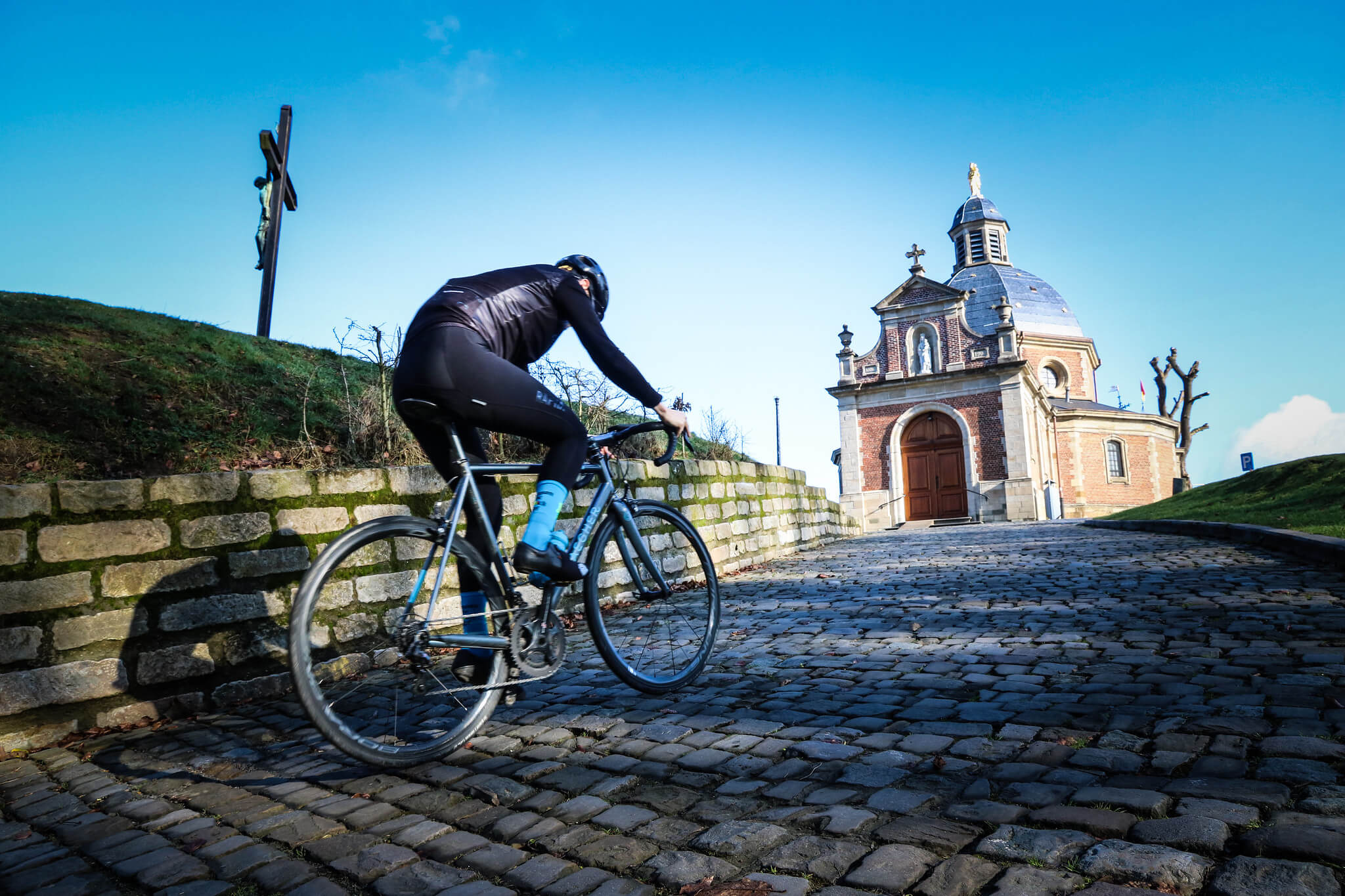
PHYSIO BIKE FIT SERIES (PART 4) Saddle Position in Cycling
A highly contentious issue
Bike fitting is a process and even an industry that sometimes lacks clear guidelines. When there are parameters or measures given, then there is even less consensus on what/ how to implement them. Polarising opinions are rife and often the loudest voice wins out. Perhaps this is due to the vast array of bikes, bodies, and bike fitters. Scientific research in the field of bike fitting and biomechanics remains in its early stages and some big questions remain unanswered. In this article, I’d like to reason through what scientific research there is, and how this applies in the clinic as well as in the cycling world.
One of the most important aspects of bike fitting is the position of the seat, ‘fore-aft’. This is how far the seat is forward or backward and is usually measured in relation to the bottom bracket (center of the pedaling circle) (figure 1). By getting this right, the muscles of the pelvis and the lower limb produce power more effectively and load is shared among the major muscle groups. By getting this wrong, performance can be hindered and discomfort or pain can also result.

Figure 1. Saddle fore-aft (forward-backward) is usually measured in relation to the bottom bracket. The pedal spindle when the crank is placed at 3’Oclock is important for judging the rider’s fore-aft position.
What happens at the knee joint?
Moving the seat forward:
This increases the work of the quadriceps (front thigh) muscles and oppositely decreases the work of the gluteal (bottom) muscles. Commonly, the quads work far too much compared to the glutes, and therefore, greater forces are placed through the kneecap joint. This is the key risk factor for knee cap pain and is the second most common cycling injury (refer to article 2) (Claes, 2015). Additionally, it has been thought that a position where the knee cap is in front of the pedal spindle at 3 O’clock (figure 2) also increases pressure on the knee cap’s cartilage. This has been refuted to some degree by a research study in 2012 (Bini et al, 2012) that found no significant change in knee cap compression forces of a forward seat position or a backward seat position (when moved 3-6cm).

Figure 2. The distance between the 2 yellow lines is the distance that the bottom of the knee cap (infrapatellar pole) is in front of the pedal spindle with the crank arm at 3 O’clock. This is measured clinically in a bike fit with a ‘plumb-line’ laser.
What Does That Mean?
Perhaps, the power of the study wasn’t enough to detect a significant change, and a smaller, undetectable change is apparent. It is possible that a small increase in compression becomes a problem over thousands of pedaling revolutions. Therefore, it appears that a forward seat position may not increase knee cap compression forces directly and a possible conclusion is that a forward seat position has no impact on knee pain in cycling…… Just shows, “it’s complicated!” This is still being debated and thrashed out.
However, what we do know is that a forward seat position does bias the quad muscles to work harder and this clearly does have the potential to aggravate and injure structures around the knee, (fat pads, capsule lining, cartilage). Therefore, in the clinic, we still see a forward seat position as a key risk factor for knee pain and will correct it. Additionally, there are no obvious performance benefits to that position from a muscle activation standpoint. Why Bias quads and inhibit the large glute muscles that are so powerful? Performance-wise, it doesn’t make sense.
Moving the seat backward:
By doing moving back, there is a proportionally smaller contribution of the quad muscles for the same power. Consequently, the glutes (bottom muscles) can activate better and do more. This should give a performance advantage because glutes are large, powerful structures. Shifting backward allows force production to be led by gluteals and shared with quads, the other key power-producing muscle in cycling. Gluteus maximus, the largest gluteal, is the most important, carrying out its ‘prime mover’ role to produce power as well as control at the hip in this position.
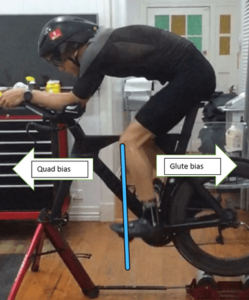
Figure 3. Moving forward means there is a bias for more quadriceps muscle group work at the same power. Moving backward biases the gluteal muscle bulk (*exception gluteus Medius posterior fibers), especially the gluteus maximus.
What happens at the hip joint?
Moving the seat forward:
In addition to the relative contribution of different key muscle groups, (quads in relation to glutes) as described above, the saddle fore-aft position has an effect on the deep ‘ball and socket joint of the hip itself (refer to figure 4). Moving the seat forward places the hip in more relative extension. This means that the thigh isn’t as close to the abdomen and is often talked about as the hip angle being more ‘open’. This sounds like a great thing and having a more ‘open’ hip angle is important in reducing pressure on the front of the hip and lower back. However, with most things in bike fitting, it is not that simple and you can definitely have too much of a good thing!
In a scenario of moving the seat further and further forward, you do see more and more relative hip extension (opening). As mentioned before, you also get more and more relative contributions of the quads and other muscles at the front region of the hip such as TFL (the high-side muscle). This has the muscular effect of drawing the ball (of the hip joint) forward and up, in the socket (Lewis et al, 2009). Consequently, it is more likely that soft tissues impinge (pinch) the cavern of bone at the front of the hip joint when the angle does become more closed-off. If this happens, more and more hip extension (opening) is required to avoid impingement. In this injury scenario, the overactivity problem of the muscles at the front of the hip is becoming worse as the knee position shifts further forward of the peddle spindle at 3 O’Clock as described in figure 2.
Moving the seat backward:
This ‘closes’ the hip angle (more hip flexion), bringing the thigh closer to the abdomen and is often uncomfortable in a static sitting. However, when pedaling a bicycle, it results in a bias to greater muscle activation at the back of the hip, especially glute max (as mentioned above). Therefore, in the hip joint, the ball is pulled back into the protective socket and is in a favorable position for hip joint movements. With this muscle activation pattern, it means that the hip can better ‘manage’ a more ‘closed’/ flexed angle.
Once again, a balance needs to be found, as moving the seat back further also requires greater flexibility of your glutes and hamstrings to maintain optimal forward pelvic tilt (refer to my previous article on lower back pain in cycling).
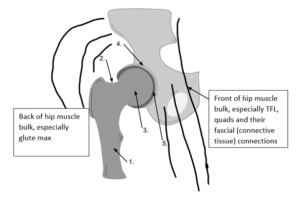
Figure 4. The diagram is looking side-on at the ball and socket joint of the hip. It depicts the significant bulk of the gluteals when compared to the smaller muscles along the front of the hip. The round head of the femur (thigh bone, number 3) sits in a deep socket. Increased activation/ tension through the muscles at the front of the hip (and less at the back) results in the ball moving forward and up on the socket. This means that it is more prone to pinching on the rim and the surrounding soft tissues at the front of the socket (number 4).
What about the hamstrings?
Clinically, treating a lot of triathletes we see a significant number of high (proximal) hamstring tendinopathies. This is an overuse injury of the hamstring tendon, (long muscles at the back of the thighs) where it attaches to your sitting bones. Tendonous tissue has a minimal blood supply and therefore, these injuries tend to be slow and frustrating to heal. Running definitely plays its role, but it is my reasoning that a seat too far forward could also be a contributing factor.
This is supported by mathematical modeling of hip joint mechanics that show, along with quads overuse, a seat that is too far forward, also increases activation of the semimembranosus (inside hamstring muscle, Lewis et al, 2009). Semimembranosus is one of your 3 hamstring muscles and its tendon is commonly injured in proximal hamstring tendinopathy (Goom et al, 2016).
The Optimal balance
From reading the rest of this article (and in bike fitting in general) an optimal balance for the seat fore-aft position needs to be found. It needs to be based upon a combination of the cyclist’s flexibility, strength, bias to use certain muscle groups, and injury history. The plumbline method of having your knee cap (specifically infra-patella pole) in line with the pedal spindle at 3’Oclock (peak power phase of the pedal cycle) remains a good starting point on a road bike. This ‘0cm’ (knee in-line) is often a good starting point for balancing the two opposing considerations of having the seat further forward (more quads work) and a seat further back (more glutes work). However, there is no value set in stone. In the clinic, we work to optimise for individuals depending on rider flexibility, and goals, as well as looking at the bike in its entirety. Unfortunately with research at this time, there is no set recipe for the fore-aft position.
Triathlete and Time Trial considerations
A triathlon or time trial bike differs from a road bike in that the cyclist has more weight (and support) on their upper body. Elbows rest on pads, as well as having their hands on long extensions. Subsequently, the rider is in a lower, flatter, and more streamlined position (refer to figure 3). This tends to bring the knees forward and make the 0cm plumbline difficult to achieve.
In addition, a lower, more aerodynamic upper body, requires even greater flexibility of the hamstrings and glutes. Therefore, having the seat backward, as if on a normal road bike (figure 1), but with a lower upper body position is tricky as well. This has led to the trend for triathletes (especially) and time triallists (within the available rules) trying to move their seat as far forward as possible.
A balance still needs to be found. Athletes try to be more ‘aero’ by getting forward but switch off their glutes. That’s a bad deal. The balance between quads and glute activation will likely be with the position of the knee slightly in front of the pedal spindle…not too much! It is my experience that this is often overdone. That is, triathletes’ seats are way too far forward.
They often do this more open hip angle to be better for running off the bike. Paradoxically, quads will do more and as discussed (with TFL) could draw the ball of the hip forwards. This potentially means structures still shorten through the front and running becomes less efficient due to quad fatigue and tightness. Athletes will sink (flex through hip and knee) losing efficiency and form. The truth is there is no strong evidence to support either argument and we really don’t know. Clinically it is my reasoning that a balance between quads and glutes use (and not front-of-the-hip overload) is still important for running effectively after riding.
Important note: “Modern frame geometry with seat tube angles >75 degrees (i.e. steeper) tends to promote a forward seat position.”
Conclusion
As you can appreciate, seat fore-aft can be a complex issue and everyone will have their opinion. In general, moving the seat forward or backward to the extreme in either direction is counterproductive. An optimal balance/ middle ground for the individual cyclist needs to be found. There is a small amount of research to guide us, but the bike fitter’s observation, analysis, experience, and reasoning remain their most important tools.
Getting your ‘Bike Fit’ right to decrease the risk of knee pain is a detailed process. Millimeters matter and the rewards come with performance as well as staying on the bike! Strength, endurance, and Bike position are essential. If you want a hand making sure all bases are covered for cycling book a time for a Bike Fit or contact us and we will chat through your situation and work out a plan to suit.
Kieran Storch
Physiotherapist
Physio Kieran is also a professional triathlete, most recently winning Mooloolaba Tri this year. He is passionate about getting Bike Fits right for performance as well as injury prevention. To chat through your issues as well as specific goals, message him at [email protected] to discuss a plan that is right for you.
To book an appointment call us at 07 3847 8040
For more information check us out at blphysio.com.au





